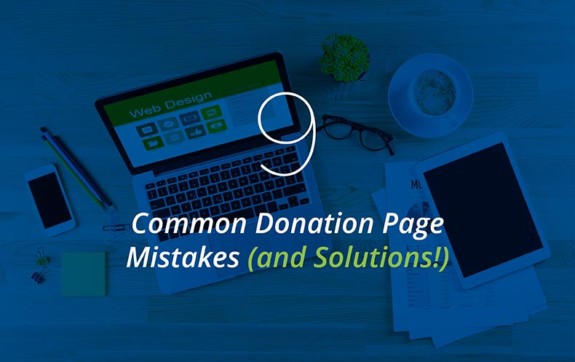9 Common Donation Page Mistakes (and Solutions!)

If your online donation form is ineffective, it warrants immediate attention. The occasional mistake is inevitable, but given the high-volume traffic nonprofit donation pages receive, it’s crucial that your donation form is optimized to be as strong as possible.
Many supporters prefer to give online on their laptops or mobile devices instead of in person. A poorly designed donation page will make you miss out on these supporters’ donations.
If your donation form needs updating, read on to learn more!
Here are 9 of the most common donation page mistakes:
- Hidden Donation Forms
- Requiring Donors to Give Too Much Information
- Overfilling Your Donation Page
- Forgetting Security Certification
- Not Being Mobile-Savvy
- Avoiding Different Giving Levels
- Not Suggesting Recurring Donations
- Ignoring Social Media
- Failing to Say Thank You
But don’t worry, we know how your nonprofit can avoid them!
Mistake 1: Hidden Donation Forms
If your supporters can’t find your donation form on your site, they can’t donate. There’s no way around it. By having a hidden donation form, you’re losing donations left and right.
Your online donation form needs to be center stage on your site and easy to use!
To further assist your donors with giving, you should:
- Include links to your donation form in your email blasts. Don’t turn every email into a plea for donations, but some emails should include links to your donation form so donors can give easily and your nonprofit receives the donations it deserves.
- Use social media to your advantage. Most adults are tweeting, posting, and liking content on social media. Include a link to your donation form in your next Facebook post or tweet so that users can easily find it. You can also include the link in your bio on social media profiles.
- Making giving easy on your site. No matter how involved a supporter is with your nonprofit, if she’s on page 83 of your blog’s archive or just arrived on your homepage, she should be able to donate easily. Place donation buttons on every page to guide supporters to your online form.
Tucking your donation form away under menus and other pages only reduces the amount of donations your nonprofit receives.
How to fix it: Include your online donation form in your online communication strategy and make sure donors can easily use your online form!
Mistake 2: Requiring Donors to Give Too Much Information
If a new prospect arrives on your website, she won’t know a lot about your nonprofit right off the bat. But if she finds that her interests align with your mission and she’d like to give to your organization, she’ll need to be able to find your donation form easily.
Because you know to keep your donation page easily accessible, your online donation form will be easy to find and your prospect will be ready to start the donation process right away.
But instead of landing on a donation page that allows her to donate right away, she has to make an account and fill out information.
No one wants to be greeted by a multitude of fields all marked “Required” on an online form, so limit the number of required fields on your donation form.
We’ve found that adding just one additional field reduces the number of completed donation forms and that adding two or more additional fields will cause your donation count to drastically drop.
If donors have to make an account, and fill out their name, address, credit card info, and a security question just to make a donation, they’re far more likely to abandon the process and never end up donating.
Forcing donors to create an account sharply decreases the number of donations that your nonprofit could be receiving with your online donation form.
Instead, try giving donors a choice of creating an account or donating as a guest. You can do this in a pop-up window that also explains the benefit of creating an account.
A cluttered donation form won’t appeal to anyone and the bottom line is that you shouldn’t require donors to make an account to donate.
Your online donation platform should give you this customization option or have preset forms that follow this structure.
How to fix it: Limit the number of required fields on your donation page for a higher donor conversion rate. Don’t require your donors to create an account to give, but provide them with the option to create a profile to track their donations and involvement.
Mistake 3: Overfilling Your Donation Page
You donation page should be just that, a donation page.
Your website is where people go to learn about your organization through success stories, videos, and updates on your projects and events. That content belongs on your website, not your donation page.
Supporters are on your donation page to donate, so don’t distract them by overfilling your donation form with background information on your nonprofit.
Follow these points to keep your donation page simple and straightforward:
- Limit your copy to a few sentences.
- Only include one image on the page and it should be at the top of the form.
- Remove sidebar navigation and menus from the page.
Adding too much to your donation form will distract from the donation and encourage traffic to leave the page.
How to fix it: Keep your copy concise and only include one picture on your donation form so that donors aren’t drawn away from giving.
Mistake 4: Forgetting Security Certification
When a donor gives online, they are submitting both personal and sensitive information so you should ask yourself, “Does your donation form reassure donors that their data is safe?”
If the answer is no, you could be losing contributions from millennials, gen Xers, baby boomers, and more potential donors!
Make sure that you include the proper security certification logos and comply with PCI Standards (Payment Card Industry Data Security Standards), and check that your payment processors are verified. This will reassure donors of your authority and credibility.
Building trust with donors is key for donor retention and your nonprofit’s reputation.
How to fix it: Include the proper security certification logos and maintain PCI compliance when it comes to your donation form.
Mistake 5: Not Being Mobile-Savvy
91% of American adults own smartphones and the past year has seen a 205% increase in mobile donations.
That’s a percentage you want to be included in.
Don’t rely solely on accepting donations on laptops and desktop computers. You’ll miss out on the contributions from donors who want to give on their smartphones, tablets, and other mobile devices.
When formatting for mobile devices, make sure your form isn’t cluttered or prohibitive to the donor’s experience. On the form, include just a brief paragraph explaining your campaign as well as your logo.
You’ll want your mobile-responsive donation page to be even simpler than your donation form for the best user experience possible. Think big, easy-to-click buttons and a vertical layout. Reduce a donor’s need to pinch and zoom!
This seamless experience will give them a quick and secure donation process.
How to fix it: Make a mobile-friendly donation page and keep it simple for a higher donor conversion rate. All the top online donation tools should have options for mobile.
Mistake 6: Avoiding Different Giving Levels
Offering different giving levels on your donation form can result in higher donations in the long run.
How? It all has to do with the psychology of giving.
If a donor lands on your donation page with the intention of donating $25 and you provide an empty field where a donor can give any amount they please, you’ll probably receive the intended $25 from that donor.
But if you offer different giving levels, like $20, $30, $40, and so forth, there’s a greater chance that this specific donor will round up and give $30 instead of down to $20 or filling in an “Other” blank.
And offering different giving amounts with appropriate descriptions allows your organization to show donors where their donations will go.
That said, along with your preset amounts, you should still include an “Other” field for donors who want to select their own donation amount. Don’t box supporters in.
How to fix it: Give donors different giving levels to help increase donation amounts.
Mistake 7: Not Suggesting Recurring Donations.
Donors have busy schedules and giving to your organization is a small portion of their lives. Help take away the stress of giving by offering recurring donations right on your donation form!
New donors might only want to give once for now, but your loyal donors are likely to give again and again.
Instead of relying on all of your donors’ memories, provide the option of automatic, recurring gifts on your donation pages.
This way, your donors don’t have to fill out a donation form every time they want to give and including this option may convert one-time donors into recurring donors.
How to fix it: Give donors the opportunity to make monthly, quarterly, or yearly gifts to bring in more donations.
Mistake 8: Ignoring Social Media.
If your donors are giving online, they most likely have social media profiles as well. They’re tweeting, posting, and commenting on a regular basis.
This is the time to include social media buttons on your donation page.
Let your donors easily share your donation page on Facebook or Twitter because it will:
- Let your supporters brag about their generosity a little.
- Spread the word about your donation page to a broader network.
Not offering social media options on your donation form is a missed opportunity because you’re losing easy shareability. Crowdfunding platforms have jumped on this opportunity, and you should too.
Donors can click the tweet button and share your donation page with little effort so give them that opportunity.
How to fix it: Give donors a way to share your donation page on social media to give your nonprofit more exposure.
Mistake 9: Failing to Say Thank You
You’re not off the hook yet. Just because a donor has made it to your donation page and given to your nonprofit does not mean your organization is done with managing that donor’s experience.
Make sure that your acknowledgement page is just as great as your donation form.
This screen needs to express your gratitude for their donation. Also let them know that they will receive an email confirmation, direct mail acknowledgement, or both shortly.
Then, direct donors to more information about your nonprofit like:
- Upcoming fundraising events
- Volunteer opportunities
- Updates on current and future projects
- Social media sites
But just remember, these follow-up links are always secondary to the actual acknowledgement.
Thanking donors is a must.
How to fix it: Your gratitude toward donors should be expressed thoroughly on the acknowledgement page, followed by additional information to involve donors.
Many of your donors will expect to give to your organization through an online form, so don’t disappoint by having a sub-par donation page. Keep these common mistakes and our solutions in mind for the best results.



